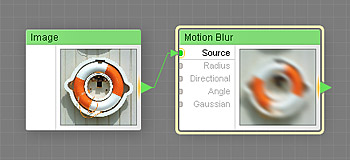
The Motion Blur applies a directional blur to the image provided by the Source input. This is a map component, it can be located in the Processing category on the Components Bar. This component can output HDR colors.
Motion Blur is a bitmap-based component – in order to produce the output image, it renders a bitmap version of the source image. Using bitmap-based components in a filter can increase its rendering time, and, in some cases, degrade the quality of the final image, so Motion Blur should be used only when necessary. For example, if you need a smooth directional noise, you can use the Perlin Noise component with high Stretch and appropriate Angle values instead of blurring a non-directional noise with Motion Blur.
Source: Map Input (HDR), Required
Provides the source image to be blurred. This is a required input – in order to make Motion Blur work, this input must be connected. This input can accept HDR colors.
Sets the blur radius. Larger values lead to stronger blurring and slower rendering. Radius is measured as a percentage of the global parameter Size. For example, if Size is set to 600 pixels, and Radius is set to 10, the actual blur radius will be 60 pixels.
Defines how directional the blur effect is. Directional of 100 results in a fully directional blur. The value of 0 results in completely isotropic, non-directional blurring equivalent to that of the Blur component.
Defines the blur direction. This parameter has no effect when Directional is set to 0.
Defines the blur algorithm. When turned on, a Gaussian blur is performed. Gaussian blur is slower but smoother and has no directional artifacts (or 'streaks'). When this parameter is turned off, a simple blur (known as 'box blur') is performed. Box blur is faster but is not as smooth as Gaussian – it has directional artifacts.